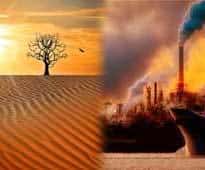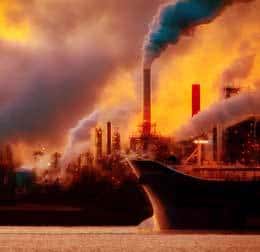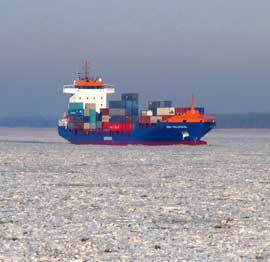Advantages Of Global Warming – Are There Any Upsides To Climate Change?

The overwhelming majority of readers will be aware of the dangerous and possibly devastating effects of Global Warming & Climate Change. But, does Global Warming have any significant advantages at all?
You can tell the meteorological and environmental effects attributed to global warming off the top of your head; Heat waves, flooding, polar vortexes, sea-level rise, droughts, and an increase in violent storms are just events that spring to mind.
With this flood of devastating events and predictions of a doomed future we are bombarded with on a daily basis, can there be any positive influences or advantages to global warming?
What Is Global Warming?
To describe what precisely Global Warming is and how it works will take so long to explain that it may merit a very long separate article or fill up the pages of a novel-sized book. But before we can talk about its numerous effects, it needs to be defined in some way:
What Is Global Warming?

Global Warming is the accelerated and sustained rise of global temperature averages spanning decades and more, in part due to human intervention. It results from activities such as the burning of fossil fuels and emissions from transport and industries, leading to the creation of greenhouse gases.
Needless to say, this is a broad and cryptic description of what is essentially a very complex phenomenon, with the numerous processes at work within it on a local and global scale.
I already touched on many aspects of global warming in other articles on this website, which you will be familiar with if you are a regular reader of posts published on this platform.
To get a better understanding of how global warming works, especially in light of human activity, you can read this article first, which focuses on the role of greenhouse gases in promoting the warming of the planet.
If you need more information on the different ways in which humans directly produce heat to accelerate the warming of the planet & atmosphere, you can read about it in this article.
Is Global Warming Real?
Before we delve into this question, let me make the following statement and put it in bold so that it is very clear and there is no confusion.
The following is for the sake of climate skeptics or believers that Global Warming is a natural process where human activity plays an insignificant or no role at all. I am not interested in convincing anyone, no matter what your stance on the subject.
I only want to answer the question that was asked in the heading with proven facts. I am not interested in who or what is to blame or in taking any specific stance on the matter.

With that said, the answer to whether Global Warming is real is a resounding yes. And this can be proven and backed up by simply looking at the temperatures officially recorded throughout the world over several decades.
Official thermometer-based keeping of temperature records started around 1850. It offers us more than a century of data to prove that Global Warming is a stark reality. But there is more evidence than just temperature readings to further substantiate this reality.
By merely looking at a few measurements and comparisons taken over time, it will soon become clear just how fast the planet's surface and the atmosphere is warming up:
1) Global Temperature Rise
Over the past 150 years, the global temperature rose by 1° Fahrenheit (0.9° Celsius.) It may sound like an insignificant change from a shortsighted human perspective.
But when you think of the timescale over which natural global climatic and geological changes take place, the whole picture changes dramatically.
If you take into consideration the fact that the Earth is 4.5 billion years old, and climate change normally occurs over hundreds of thousands of years, you will realize how significant and rapid this change is.
2) Rising Sea Levels
Over the last century alone, the sea level rose by around 7 inches (178 millimeters). Like temperature, it may not seem like that much to you if you don't look at it in context.
Take into consideration that the oceans cover 71 percent of the Earth's surface. If you think of the sheer magnitude and scale, you will start to realize just how much ice and snow have to melt to raise such a vast surface by 7 inches.
All this additional water is a result of the melting of ice. The polar ice caps, glaciers, and snowpacks that stayed in their solid form for thousands of years have started to melt due to the increasing rate of temperature rise.
3) Highest Carbon Dioxide Levels Ever
Currently, carbon dioxide levels are the highest they have been in 650 000 years. If you are not familiar with carbon dioxide, this may not seem that relevant.

Carbon dioxide is a greenhouse gas, which means it is a form of gas that prevents heat from escaping the atmosphere, trapping the warm air near the planet's surface. (In part, CO₂ is the result of emissions created during the burning of fossil fuels like petroleum and coal.)
This process contributes to the buildup of heat in the atmosphere. And the higher the concentrations of CO₂ in the air, the larger the amount of warm air that gets trapped.
If you want to find out more about carbon dioxide, you can read all about how it is created and its effect on the environment in this article.
4) Shrinking Ice Sheets
Satellite data from NASA shows that the ice sheets in both Antarctica and Greenland have been losing ice at an alarming rate of 413 gigatons per year combined since 2002. (If you can wrap your head around it, that is 413 billion tons of ice...)
This dramatic reduction in size is a direct result of warmer air and ocean surface temperatures. What is even more distressing is the rate at which the ice sheets are shrinking, which has started to accelerate since 2009.
It should start to become clear that there is little doubt that Global Warming is real, with more than a century's worth of data backing it up. And it shows no signs of slowing down.
Advantages Of Global Warming
Many of the negative impacts of Global Warming have already been highlighted in this article. It leaves us with the question of whether there can be any positive effect or benefit to this ongoing phenomenon.
Over time, it is clear that most long-term disadvantages will outweigh and eventually eliminate any short-term advantages.
For a limited period of time, however, some of the side effects of a warming planet will benefit and create new opportunities for certain industries and sectors. It will even have some temporary health benefits:
1) Less Winter Related Illnesses
Countries that traditionally experienced very cold winters may show a decline in deaths related to persistent icy weather as Global Warming continues to warm up the planet.
Cold weather is 20 times more fatal than warm weather. This theory is the brainchild of Antonio Gasparrini (London School of Hygiene and Tropical Medicine).
He proved his theory in a study where he examined 74 million deaths. From the total, 5.4 million fatalities were attributed to cold weather, while only 311 000 were related to warmer weather conditions.
Cold-related deaths are more prominent in people with developing or weak immune systems, such as children and the elderly. If you are interested, you can find more details about the effect of cold and warm weather on human health in this article.
2) New Shipping Lanes
The Arctic is warming at twice the rate of the rest of the planet. It is a result of Arctic Amplification, a process you can read more about in this article.

Combined with warmer ocean surface and air temperature, it is causing the ice to melt at an increasing rate. One temporary advantage of the accelerated shrinking of the ice sheets is that parts of the region that were previously covered with ice are now open waters.
This is especially beneficial for the North Sea Shipping Lane. It runs through the Arctic and is a much faster (and more economical) path to carry oil from Norway and Russia to global markets.
Currently, it is covered with ice for large parts of the year, making it inaccessible. As temperatures continue to rise, more ice will melt, and it may open the shipping lane for extended periods and possibly on a permanent basis.
The rapid melting of ice can also open entirely new shipping lanes that are currently not even under consideration or seen as a possible crossing.
3) Growth In Certain Agricultural Sectors
Countries in the Northern Hemisphere (close to the Arctic Circle) that were covered with snow for large parts of the year, with accompanying low temperatures, are now presented with new opportunities in the agricultural sector.
Warmer temperatures that lead to less snow have freed up more fertile ground and created favorable conditions for the growth of crops that were previously impossible in countries like Sweden, Denmark, Finland, and Canada.
It is estimated that Northern Europe can expect a 30 percent increase in the production of wheat, while Finland and Sweden may see a 50 percent increase in areas suitable for the growth of corn. (Canada and Greenland can see similar advantages.)
4) Increased Plankton Biomass
Plankton Biomass (phytoplankton) is at the bottom of the marine food chain, which feeds the smallest marine organisms. In turn, they provide nutrition for larger marine species.
Warmer temperatures will result in an increase in the production of plankton biomass since phytoplankton makes use of the sun's energy to turn carbon into protoplasm (living cells in a plasma membrane) through a process called photosynthesis.
With more nutrition available, higher levels of phytoplankton can lead to an increase in volume and biodiversity of marine life in the ocean. Depleted or endangered fish species may also be given a chance to recover, while their numbers can start to grow again.
Conclusion
There are a few crucial facts that got highlighted in this article. One is the clear evidence and reality of Global Warming. The second takeaway is that there are some short-term benefits to a warming planet, but they have to be seen in context.
The emphasis of these benefits is that they are all short-term. Some countries and industries are already seeing some of these advantages, while others will experience them in the near future if global temperatures continue to rise.
If the planet keeps on warming past the point of being a benefit, everyone will be negatively impacted, even those who experienced a temporary advantage.
Looking at Global Warming from a slightly different perspective helps one to understand the process and consequences of a warming planet even better, and what it means for humans and the environment in the future.
Never miss out again when another interesting and helpful article is released and stay updated, while also receiving helpful tips & information by simply clicking on this link .
Until next time, keep your eye on the weather!
